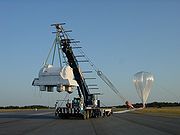
Research balloon
Encyclopedia

Balloon
A balloon is an inflatable flexible bag filled with a gas, such as helium, hydrogen, nitrous oxide, oxygen, or air. Modern balloons can be made from materials such as rubber, latex, polychloroprene, or a nylon fabric, while some early balloons were made of dried animal bladders, such as the pig...
s that are used for scientific research. They are usually (though not always) unmanned, filled with a lighter-than-air gas like helium
Helium
Helium is the chemical element with atomic number 2 and an atomic weight of 4.002602, which is represented by the symbol He. It is a colorless, odorless, tasteless, non-toxic, inert, monatomic gas that heads the noble gas group in the periodic table...
, and fly at high altitudes
High altitude balloon
High-altitude balloons are unmanned balloons, usually filled with helium or hydrogen that are released into the stratosphere, generally reaching between ....
.
Meteorology, atmospheric research, astronomy, and military research may be conducted from a research balloon.
Weather balloon
Weather balloon
A weather or sounding balloon is a balloon which carries instruments aloft to send back information on atmospheric pressure, temperature, humidity and wind speed by means of a small, expendable measuring device called a radiosonde...
s are a type of research balloon. Research balloons usually study a single aspect of science, such as air pollution, air temperature, or wind currents, although sometimes several experiments or equipment are flown together.

Auguste Piccard
Auguste Antoine Piccard was a Swiss physicist, inventor and explorer.-Biography:Piccard and his twin brother Jean Felix were born in Basel, Switzerland...
in the 1930s.
Research balloons are not only used on earth. With the help of a research balloon, the upper atmosphere of Venus was examined by the Vega program
Vega program
The Vega program was a series of Venus missions which also took advantage of the appearance of Comet Halley in 1986. Vega 1 and Vega 2 were unmanned spacecraft launched in a cooperative effort among the Soviet Union and Austria, Bulgaria, Hungary, the German Democratic Republic, Poland,...
.

